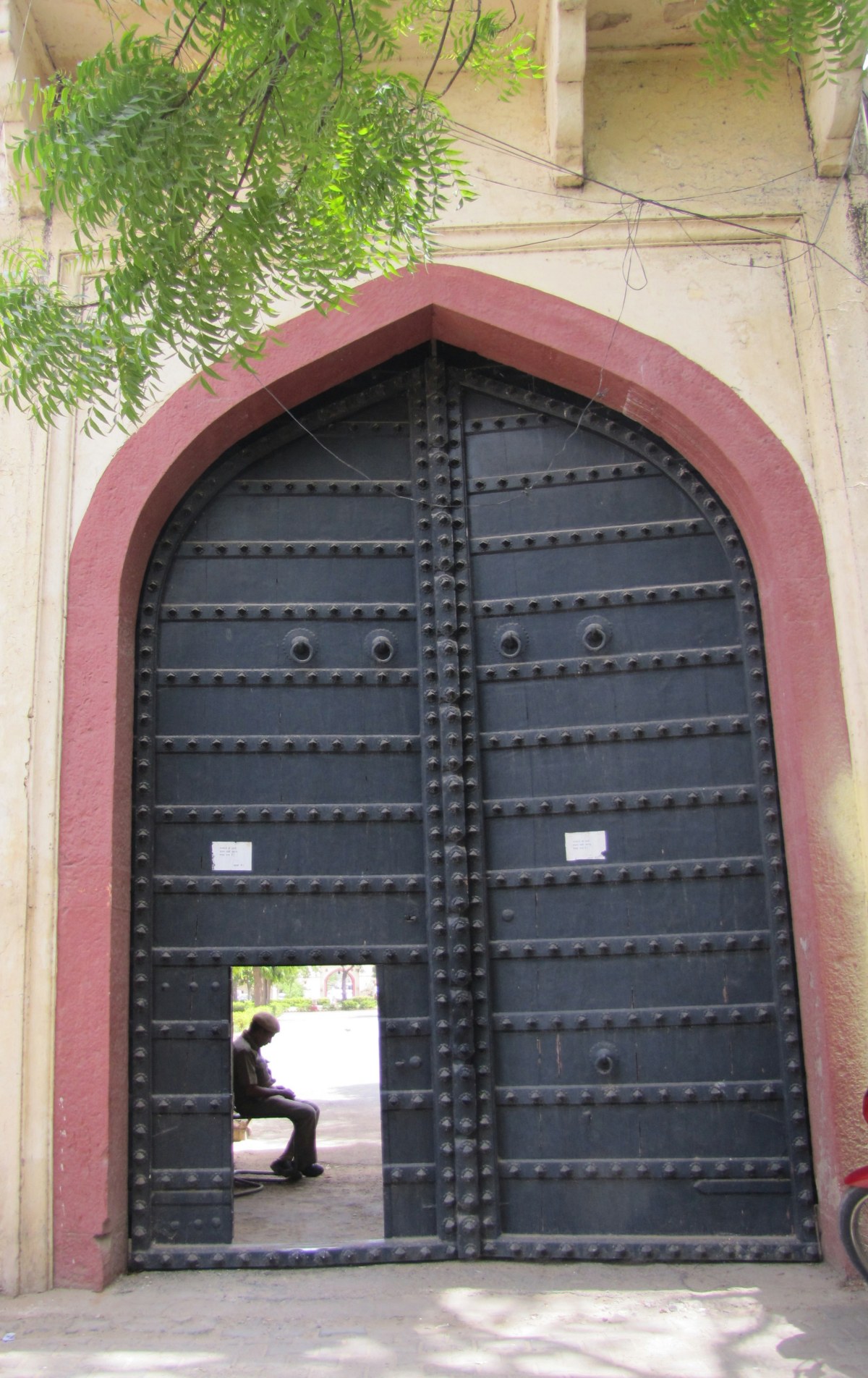
travel along with me



“Gar firdaus bar-rue zamin ast, hami asto, hamin asto, hamin ast.”
“If there is a heaven on earth, it’s here, it’s here, it’s here.”
In order to relieve yourself from the scorching heat of your town, this is one perfect destination to chill out during summers. Srinagar is overflowing with trimmed grasslands, blooming tulips in summers and dehlias in winters. The gardens to visit in Srinagar:
Shalimar Garden: The history of this garden traces back to the founder of Srinagar Pravarsena II, who reigned the city from A.D. 79 to 139, constructed a rest house surrounded by a garden at the edge of right bank of Dal Lake. Later, this garden was renovated by Emperor Jehangir for his beloved wife Noor Jahan in 1619 AD. The word “Shalimar” derived its etymology from Sanskrit and means “Abode of Love”.
“A subtle air of leisure and repose, a romantic indefinable spell, pervades the royal Shalimar: this leafy garden of dim vistas, shallow terraces, smooth sheets of falling water, and wide canals, with calm reflections broken only by the stepping stones across the streams. – C.M. Villiers- Stuart in “Gardens of Great Mughals”
The garden is built in covered terrace fashion, as one keeps on climbing up through sides of canal. The garden is divided into two halves by a canal flowing in the center. In the midst of the canal, stones are constructed where one can stand and feel the showers of fountains. There are beautiful fountains built up in a vertical fashion in the center of the water canal. The water of canal cascades down the terrace like a waterfall. The sides of canal are covered with bed of flowers. The garden has beautifully trimmed grass, meticulously manicured trees and covered with variety of beautiful flowers and shrubs. At the uppermost part of the garden is a roofed palace where one can sit and have a picturesque view of the flowing canal and fountains.
One can visit the garden during day time. It gets closed after 1730 hours. The timings might change during seasons. And in order to upkeep the garden, the maintenance department of the garden charge a nominal entry fees. If you are visiting the garden in evening then do not forget to watch the light and sound show at the garden, organized daily during tourist season from May to October.
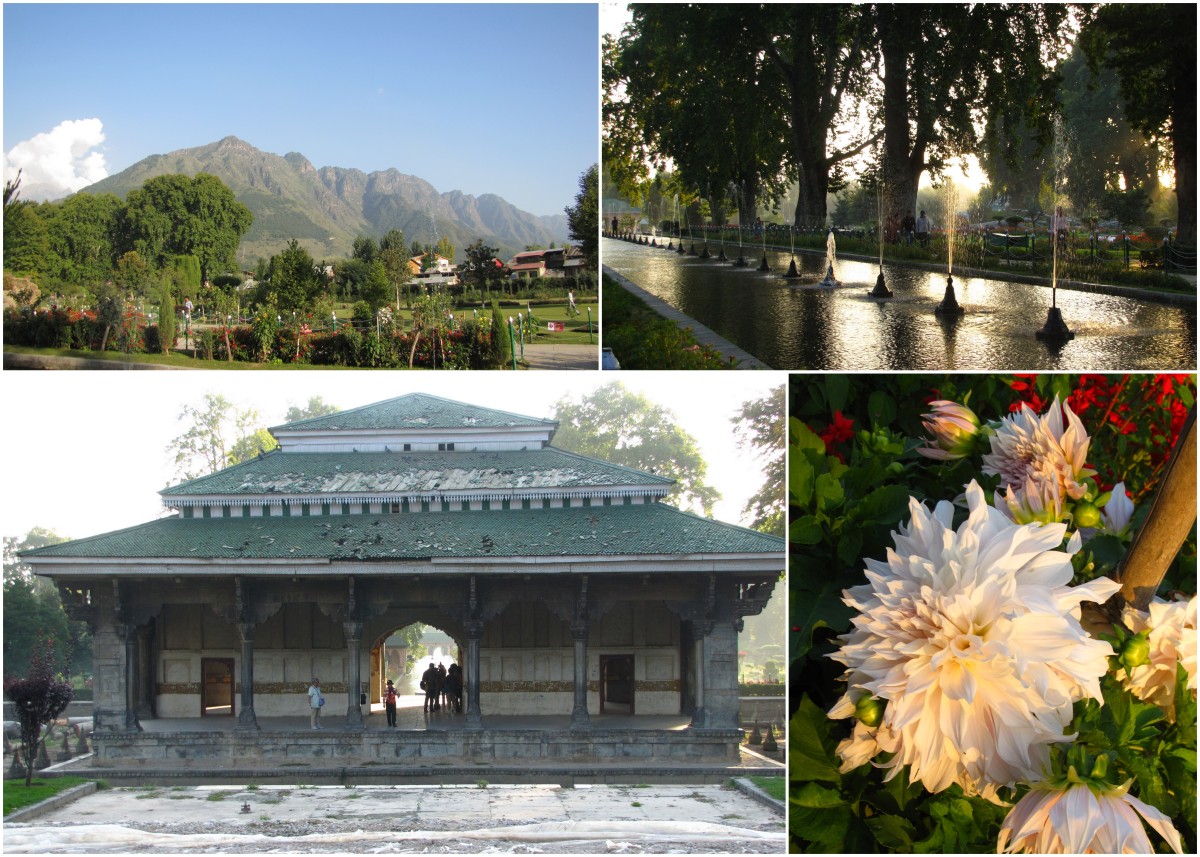
Click here to read about Nishat Gardens, Kashmir
My penchant for windows is increasing and so is my seeing them from a different angle and thoughts surging about these window designs.
This photo of an illuminating window has been clicked by my brother at City Palace, Udaipur. I think that the forlorn location of the palace from the usual humdrum of lives were replaced by these illuminating and glowing colors of windows. In all the palaces across Rajasthan, the colorful glowing window glass panes are quite common to brighten up the lives. Another reason is to protect the inhabitants from the direct sun rays and using the colors to give a soothing effect and treat the inhabitants with the power of colors.
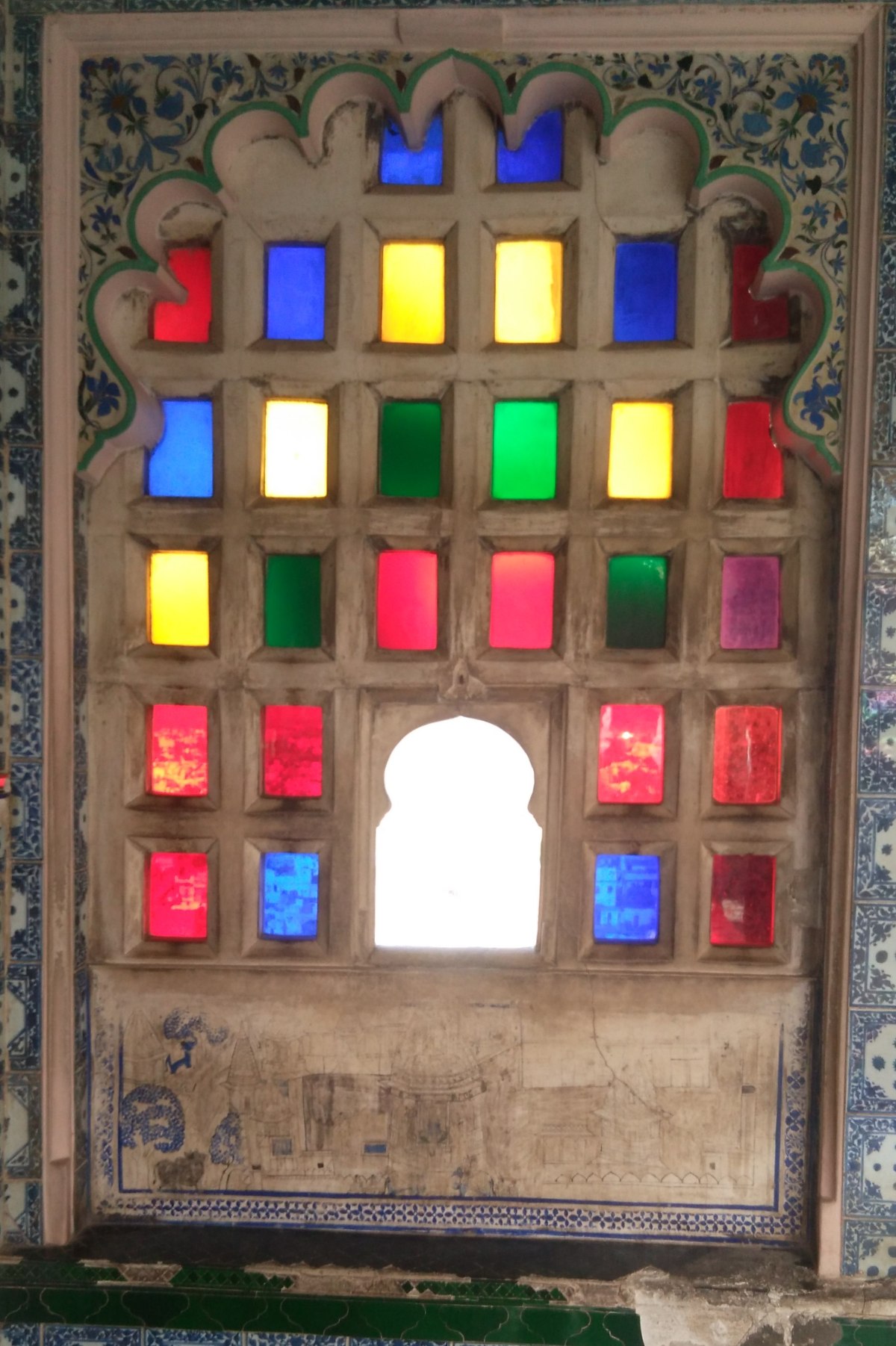
“Color is a power which directly influences the soul.” Wassily Kandinsky
Another photo of window is the airy chic window, clicked at City Palace, Udaipur, Rajasthan.
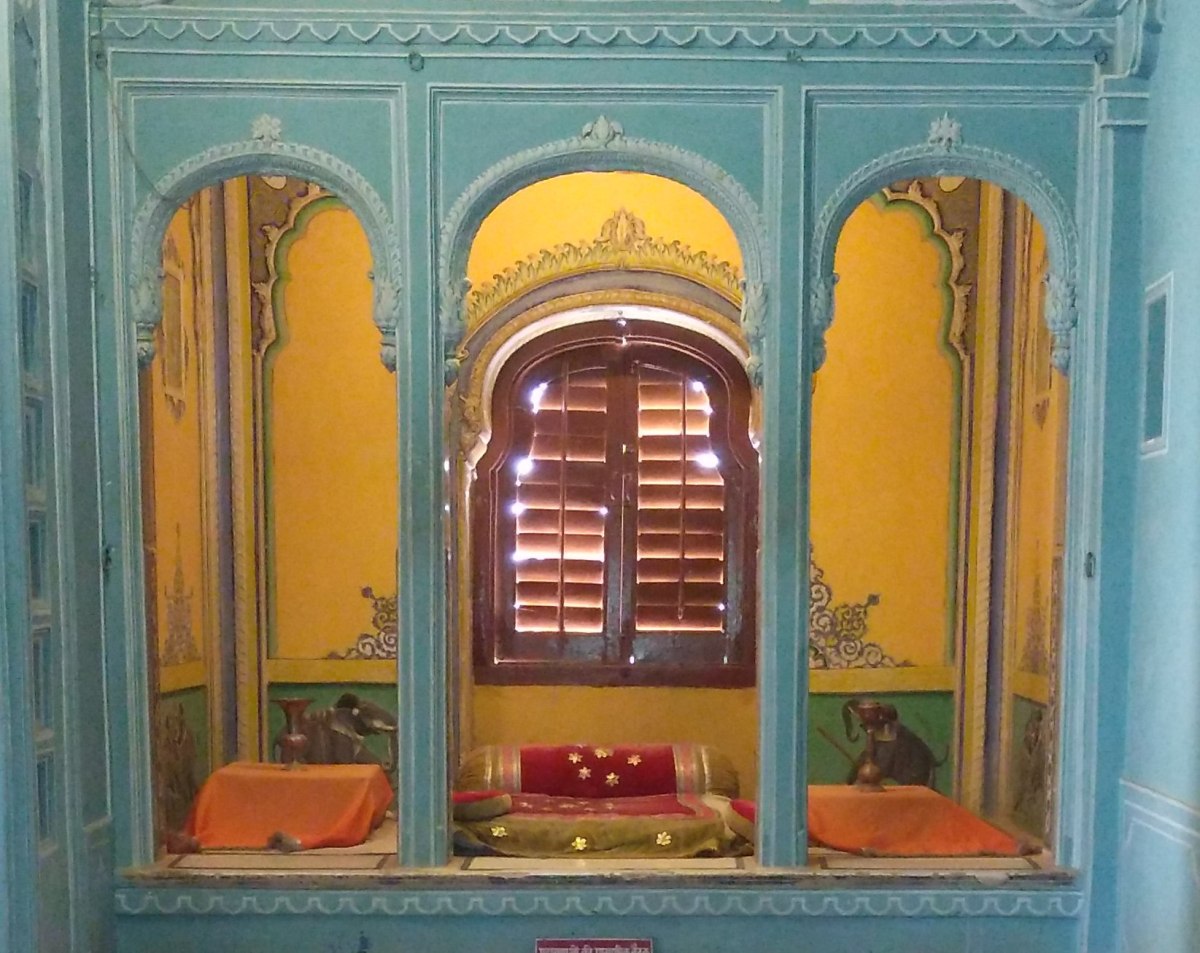

Recently, I saw a closed window above the door or an upper part of the door. It lets the light enlighten the room, when the door is closed. Similarly, in this photo, the glasses of the window have been colored in a symmetric fashion to make the room more fascinating.
This photograph has been clicked at Mehrangarh Fort, Jodhpur, India.
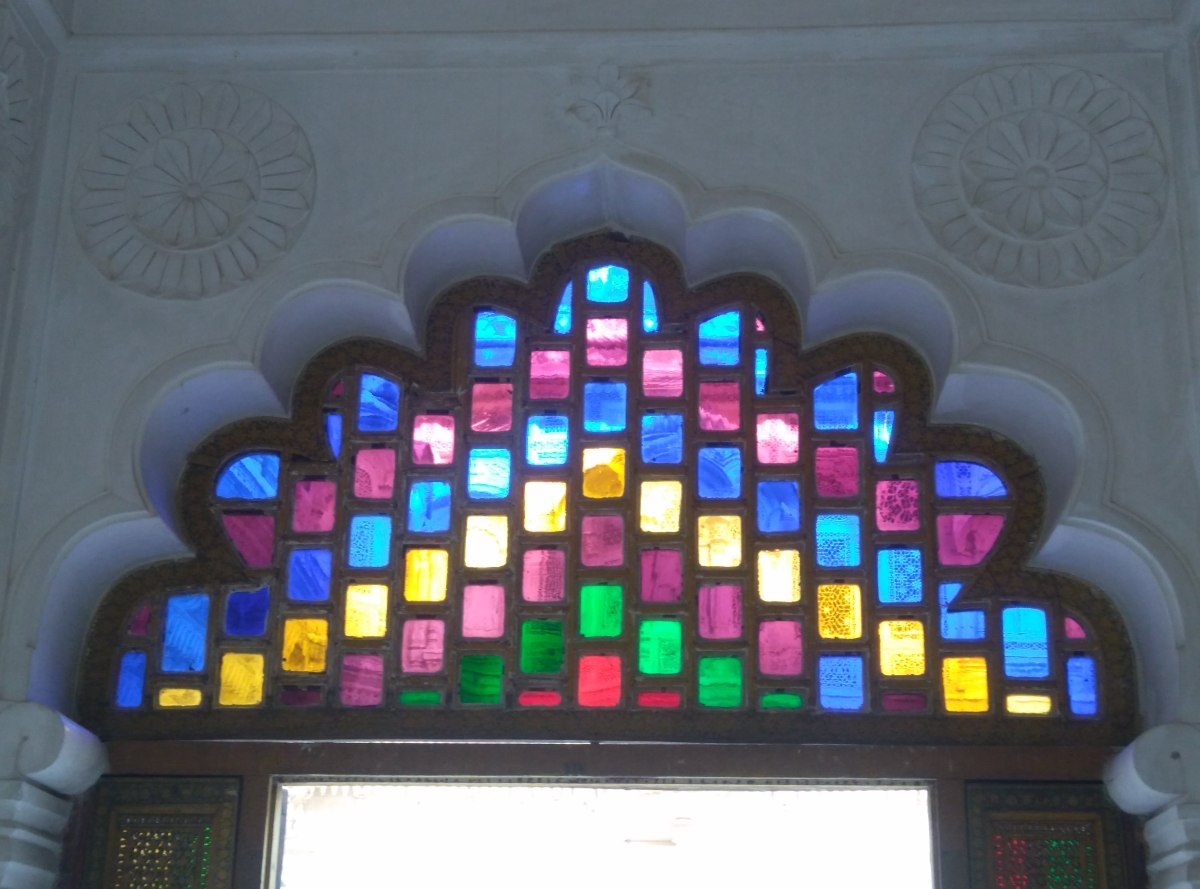
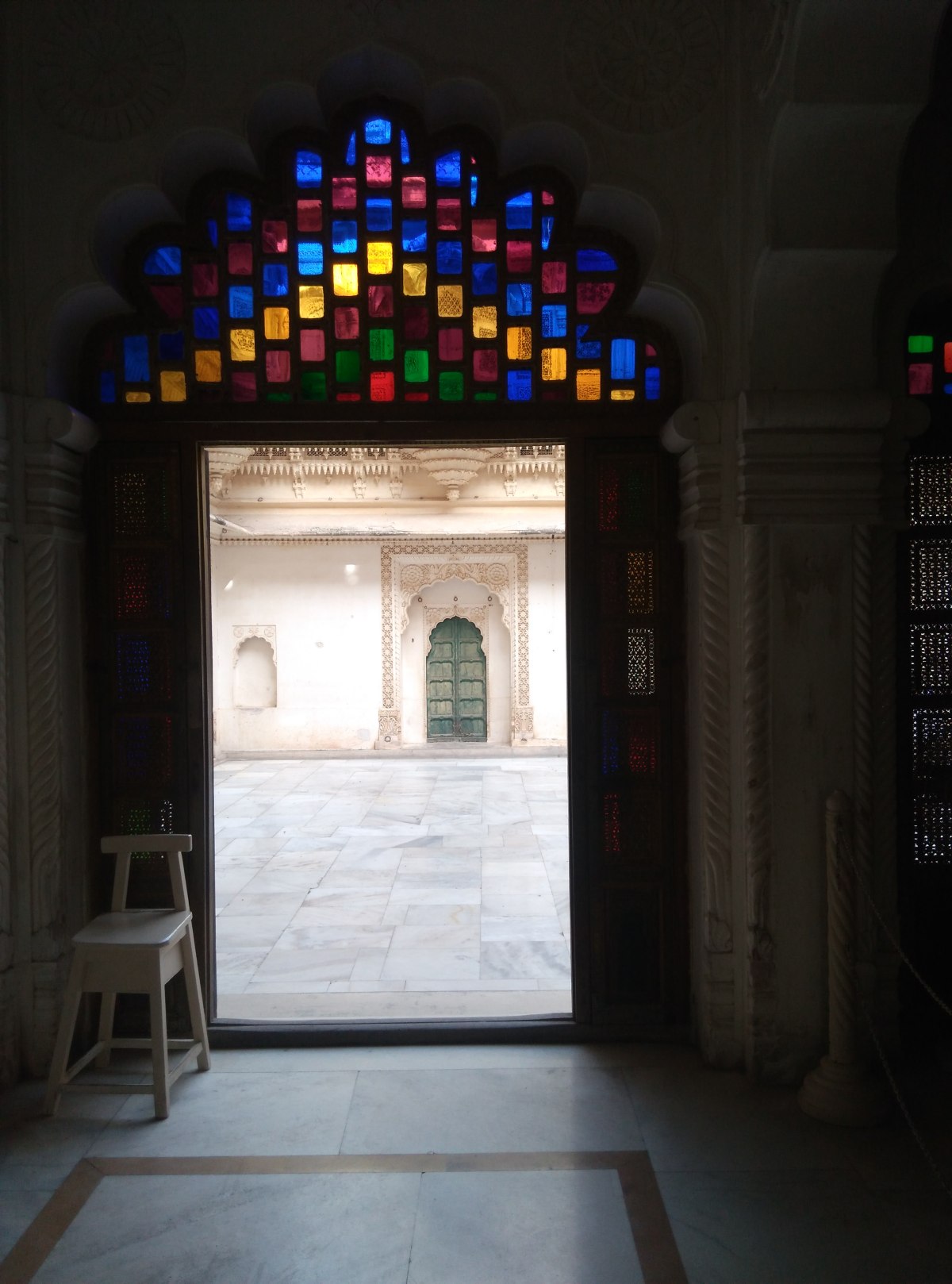
During summers, the hot wind blows and it brings in sand along with it. In order to protect against hot winds and to keep the homes clean, the households close the doors. The windows are designed above the doors to make the insides illuminated with natural light.


At sunset, the nature is painting for us day after day-the infinite beauty. -John Ruskin
Whatever Midas touched turned into gold and during sunset the skies as well as the water reflects a splendid golden color.
In evening, I love to sit at the edge of a precipice of a hill and watching the sunset with a friend holding hands with a wish to watch every sunset and reminiscing the time spent together.
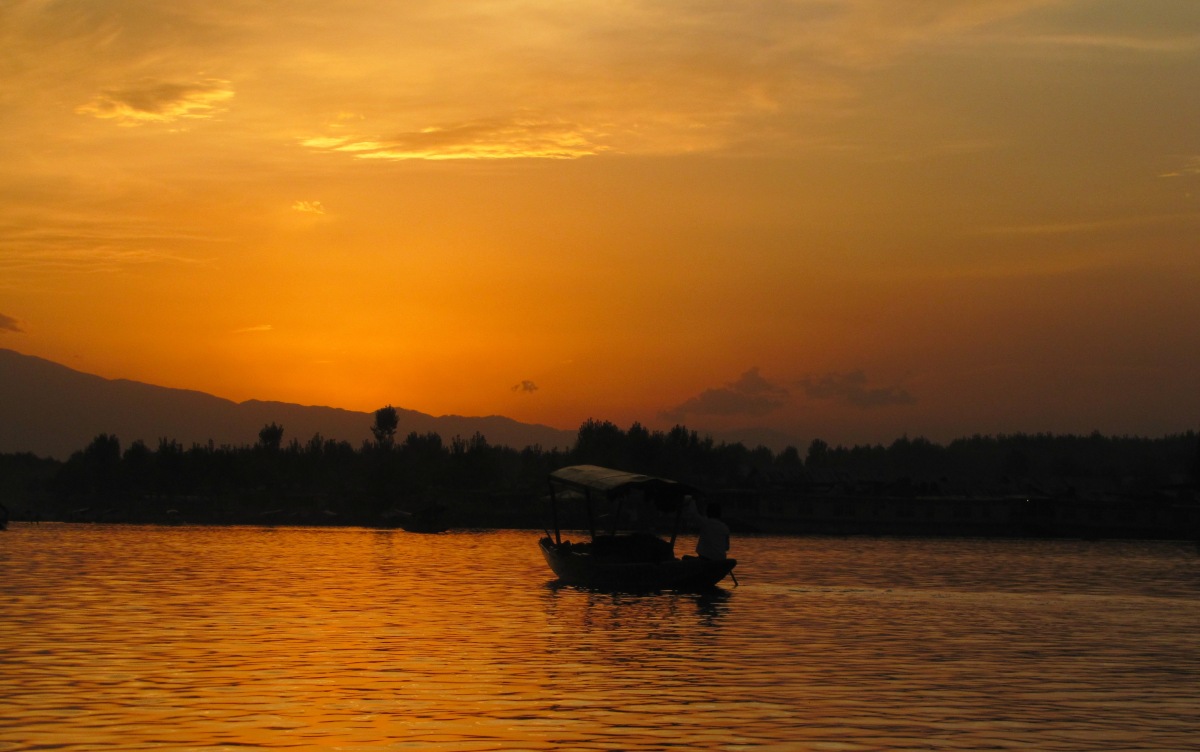
I clicked this photo while boating in a Shikara at Dal Lake, Srinagar. The golden color of the water of Dal Lake and the skies enchants me and brings back lots of memories. The pleasure ride on shikaras and capturing the Dal Lake, mountains in the backdrop towards the north and the Kashmir Palace towards the west and capturing the awesome views in my camera is one thing which I cherish till date and would love to experience in future as well.
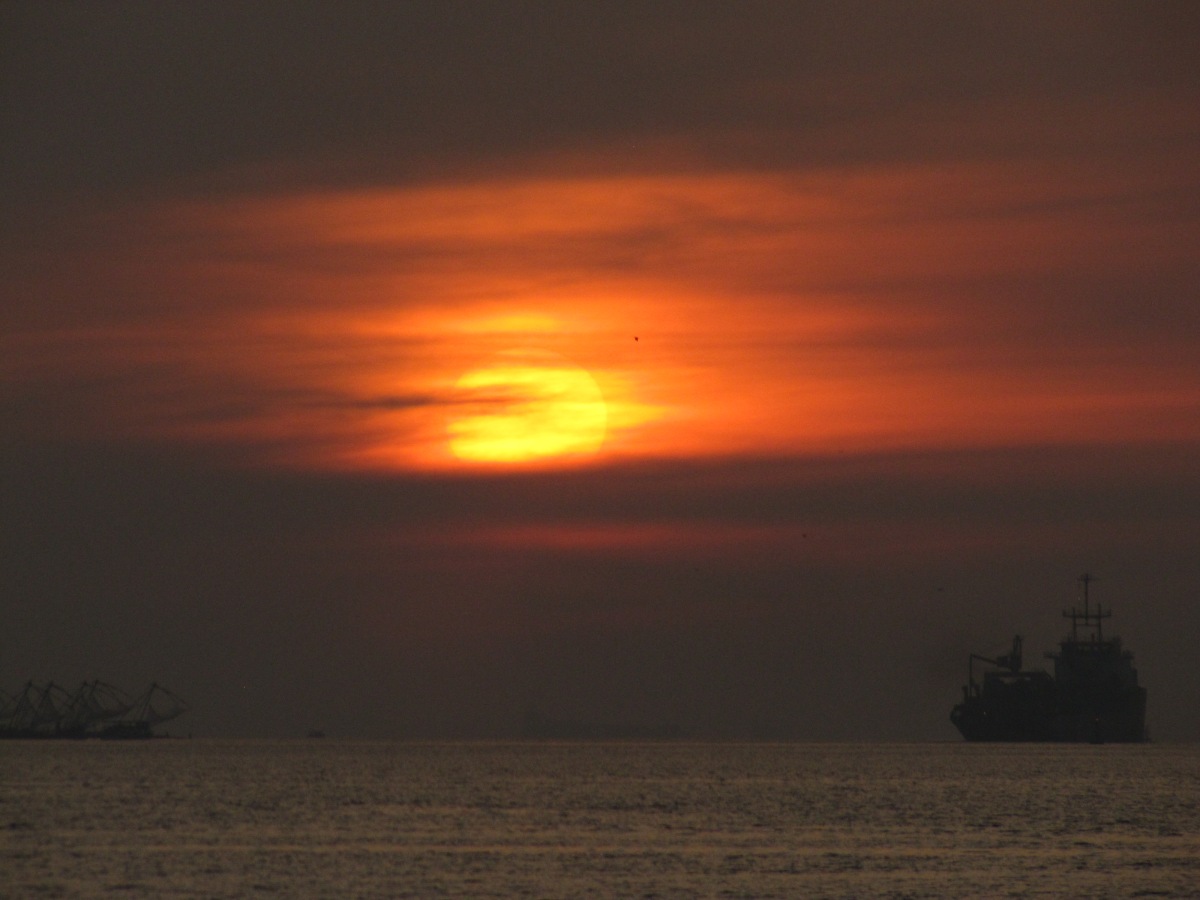
Earth and sky, woods and fields, lakes and rivers, the mountain and the sea, are excellent schoolmasters, and teach some of us more than we can ever learn from books.
-John Lubbock
This photo was captured by me at the Kochi Beach. The Sun, the sea, the voyages and Chinese fishing nets are making the picture perfect.
The beginning of a journey for the voyages to a new destination. The urge to see new horizons of nature, meeting new people, a beginning of new relationships-may be business related or culture related or simply a connection between souls of the Universe.
Suns
Udaipur, well known as “Lake City”, adorns picture postcard scenery of a wonderful combination of lakes and gardens.
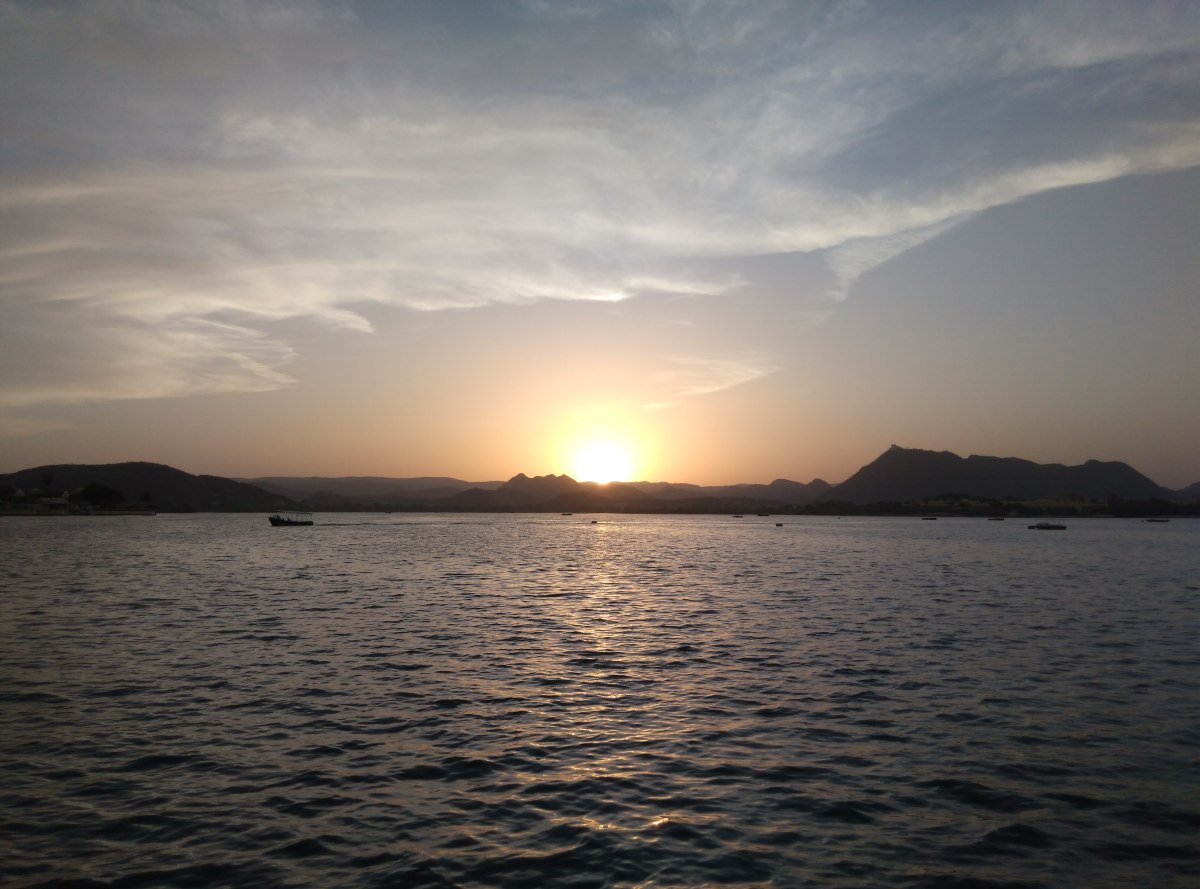
Recently, my brother had an opportunity to visit Udaipur and he clicked this serene photo of sun setting beyond the Aravalli hills at Pichola Lake.

Fruits are acceptable gifts, because they are the flower of commodities, and admit of fantastic values being attached to them. If a man should send to me to come a hundred miles to visit him, and should set before me a basket of fine summer-fruit, I should think there was some proportion between the labor and the reward.
Ralph Waldo Emerson, “Gifts”, Essays, Second Series (1844)
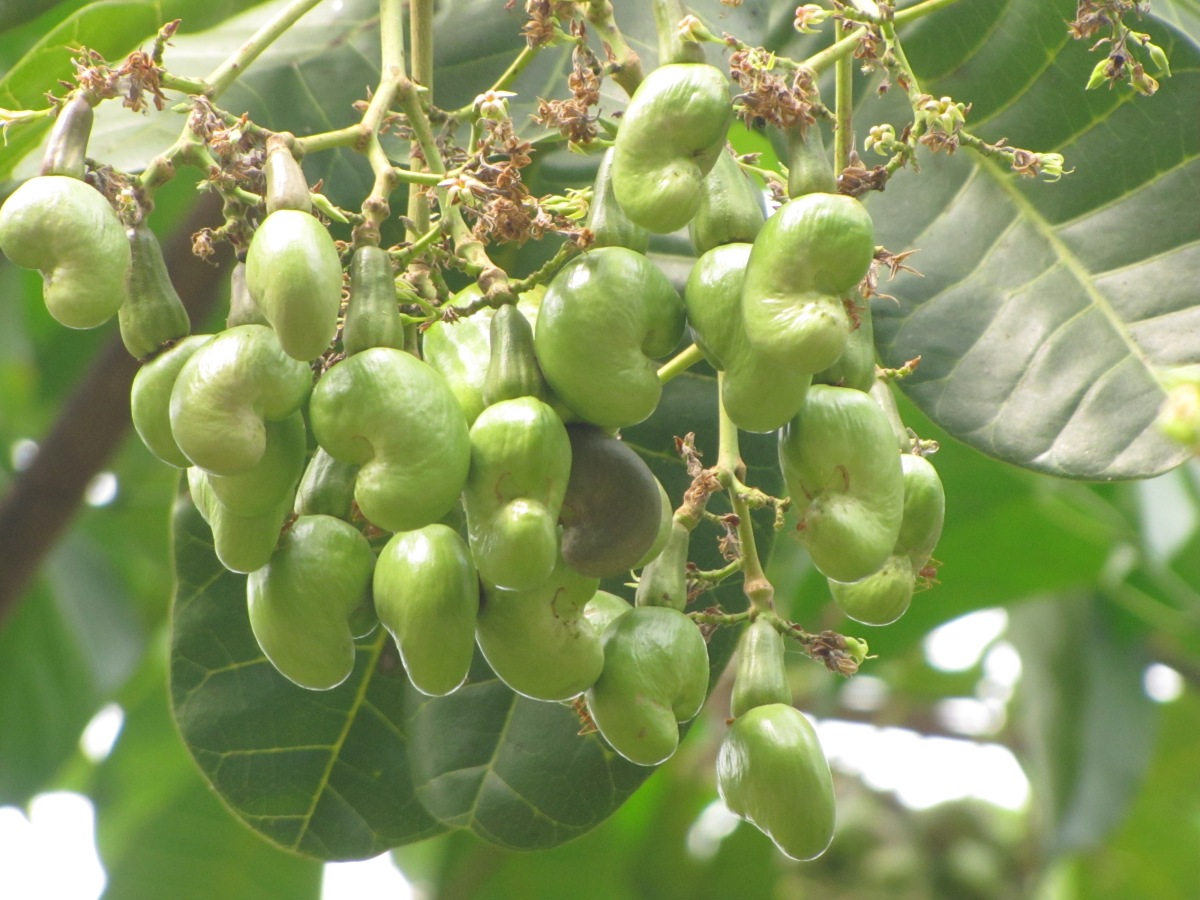
Cashew flowers, cashew apple and cashew nut
Out of curiosity, I asked my friend about cashew nuts during a stroll down the hill. He elaborated on the way a cashew nut outgrows from the cashew fruit (called as “cashew apple”) and I carefully listened to him with attention to the details.
To my astonishment, he told me that cashew nut is a part of the cashew fruit called as cashew apple. He explained that the fruit looks more like a pear and is three times larger than the cashew nut and the outgrown part which looks like a kidney shaped bean is the outer cover of cashew nut. Cashew nut is actually a seed of the fruit covered with the shell. The cashew nut needs to be processed before one can eat. As the outer cover (shell) contains certain toxics which could be fatal to one’s health and may cause itching and skin allergy on lips if eaten raw.
The cashew fruit is very juicy and refreshing. The cashew fruit comes in yellow and red color. It cannot be transported to the other parts as the fruits are very delicate in handling.
Though in the above photograph, one can observe the dried flowers, a small and slender shaped cashew apple (green in color) hanging above the outgrown seed, better known as cashew nut.

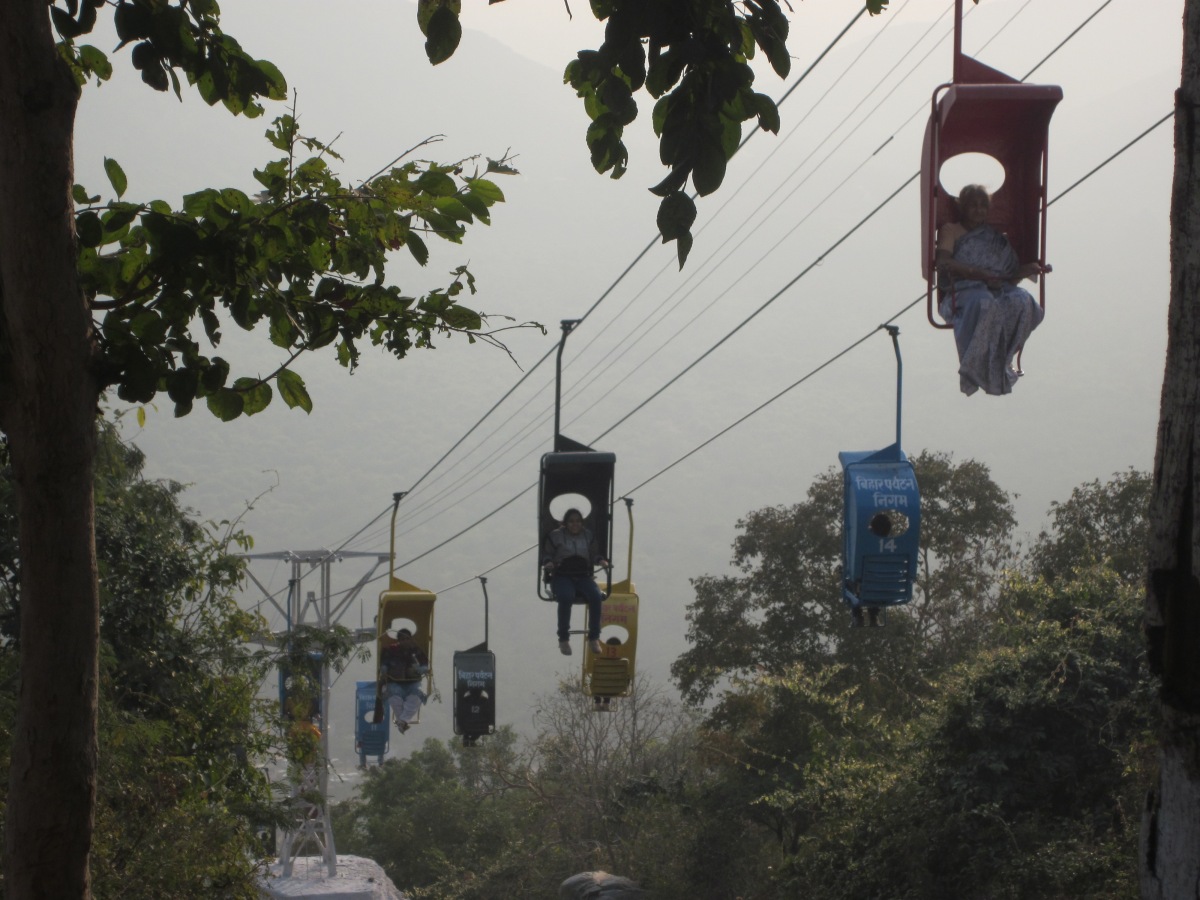
Connection to the Peace
The ropeway connects people to the serene environment at the World Peace Monastery.
Vishwa Shanti Stupa is located in Rajgir city located in Nalanda district of Bihar, India. There are two ways to reach Shanti Stupa, one is through stairs and the other one is through the ropeway. Visitors who do not want to strain their knees can take a ticket to ropeway to reach Shanti Stupa. While passing through these ropeway, one can watch the scenic views of dense forestation, and a few seasonal small streams. Vishwa Shanti Stupa (World Peace Monastery) is located, at the top of the hill.

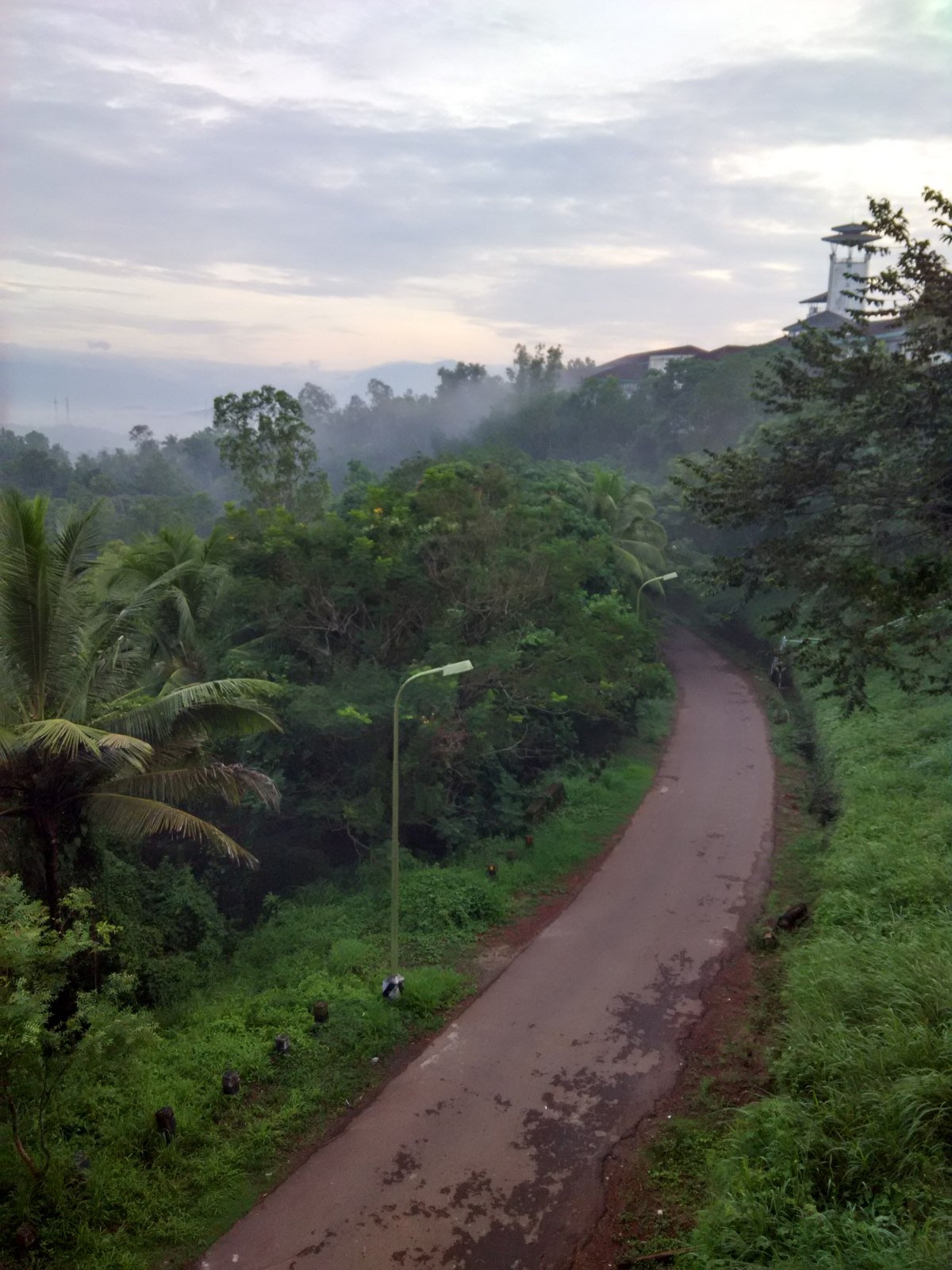
The Road Less Travelled
I like to visit places which are away from the cacophony of the city. A place where I can clearly listen to the chirps of birds, buzzing of insects, feel the fresh breeze, breathe in pure air or in other words, a serene environment.
And one of the obvious reasons is I can click photos in a more focused way. I like to write about the travel destinations which are less travelled and least written about. In a way, giving a fame to these destinations and bringing them on the travel map.
I have clicked this photo by my mobile camera during my stay at IIM Kozhikode, INDIA.
This is my entry to Photo101 “Solitude and the Rule of Thirds”

“I like to stare out of my window overlooking my garden to feel the fresh breeze brushing against my face, smell the fragrance filled with scent of roses, listen to the melodious voice of cuckoo and watch the little kitten playing in the grass.”
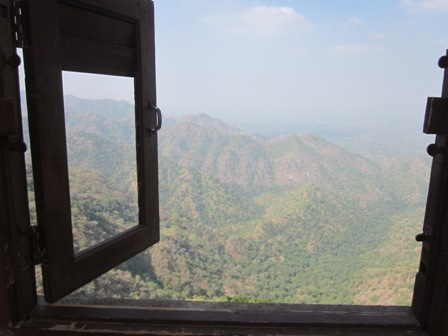
Windows have always attracted me, whether it’s a window of my home, or a hotel room, or a palace or a fort. They are the ways for me to look outside the boundaries of room. A window overlooking the vast sea, or the Himalayas and the sun rising above them overwhelms me with the new hopes and fills me with opportunities the Universe is presenting before me.
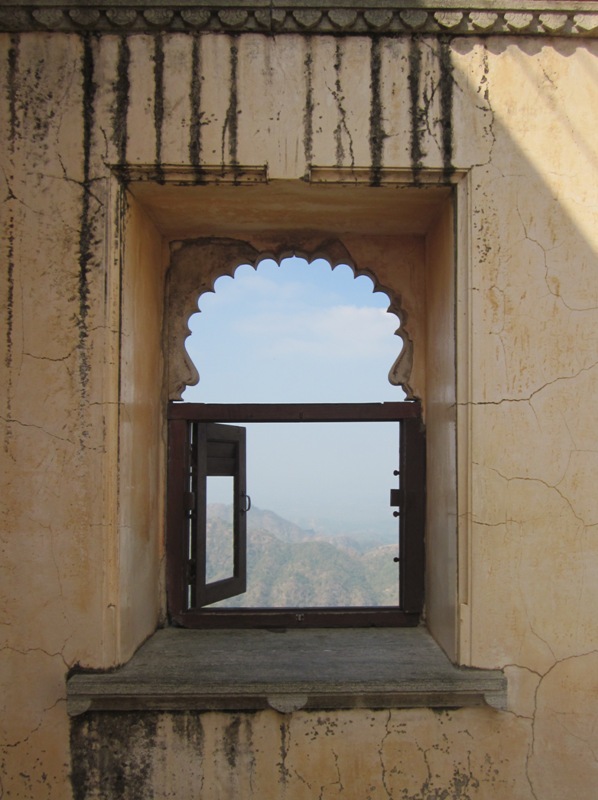
I captured this photo of window, when I visited Kumbhalgarh Fort, Rajasthan, India. This window is constructed on the boundary wall of terrace of The Badal Palace at Kumbhalgarh Fort, which is the topmost point of Fort. One gets the feeling of wandering in the clouds at this point of the Palace. Here, one can enjoy the panoramic views of Aravali Ranges. The windows at the terrace are constructed in a manner that one can sit on the sill and enjoy the scenic beauty and the droplets of water during rains. The windows of Fort are known as “Jharokha”. These Jharokhas were constructed to keep a vigilant eye on the movement inside and outside the Fort. However, in the photographs, one can witness that these Jharokhas are in its ruins and needs restoration.

For part 3, click here: Part 3
Day 8: Trek from Nagroni to Nauya Tapru via Chandrakhani pass, Distance – 14 km (approx) (9000 ft) (7 hrs, according to YHAI) (I took 11 hours to complete the trek)
We got up in morning at 0200 hours, deposited sleeping bags and blankets. Had breakfast at 0300 hours, and collected packed lunch which included mathri and frooti. We started our trek in morning at 0330 hours. All the trekkers carried headlamps or hand torches. We were trekking on rocky edged trails to narrow trails. Soon there was sunrise; the sun was behind the clouds. We witnessed all the colors of trekking. First, it rained, then hailstorm and ended with snowfall.
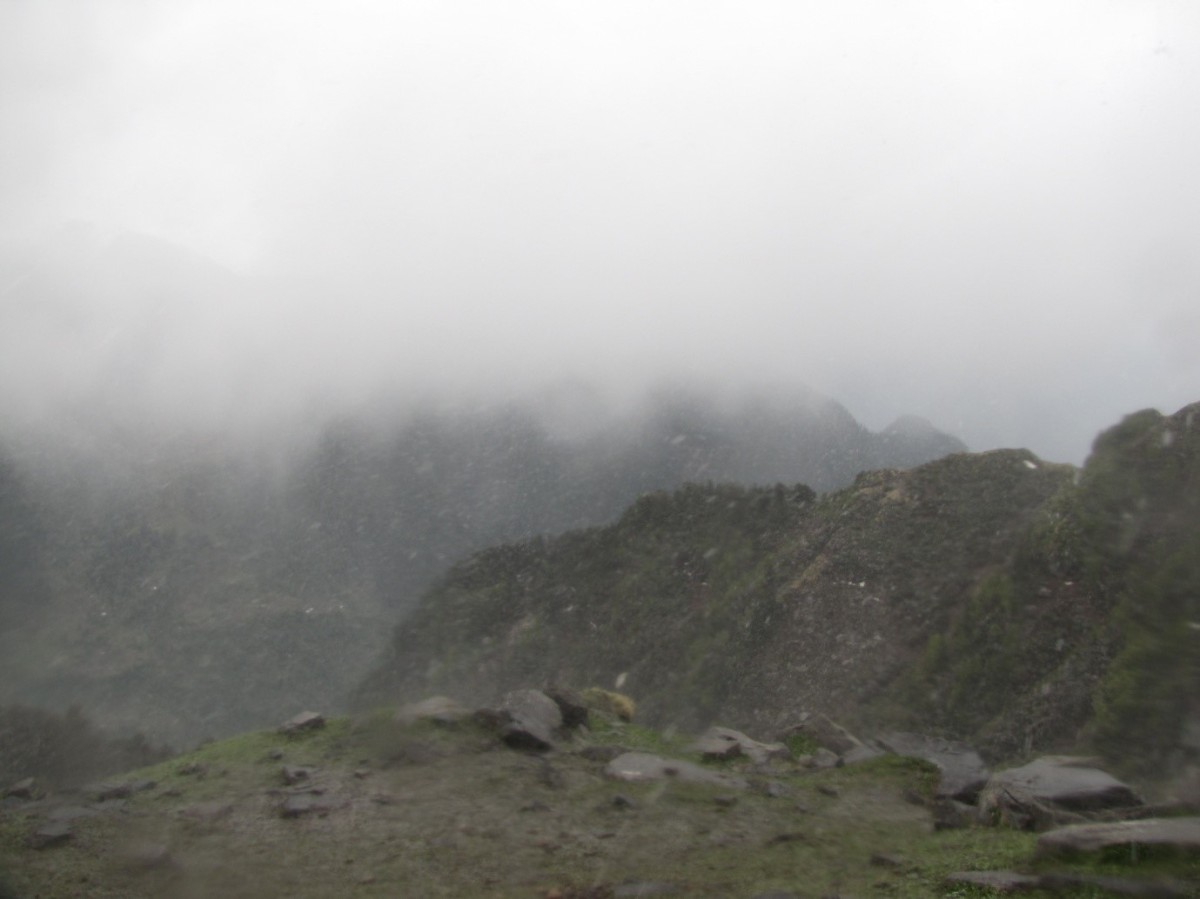
Snowfall during trek to Chanderkhani Pass
During snowfall, we were trekking on a narrow trail. The snow was small and stuck to my wind cheater. It was white and smooth. As it is clear in the above photograph that visibility reduced to minimal. Snow was directly coming in our direction. Instead of stopping, we kept on moving with a small and cautious steps.
As we kept on going up and up, the scenic views were awesome and the most beautiful ones.
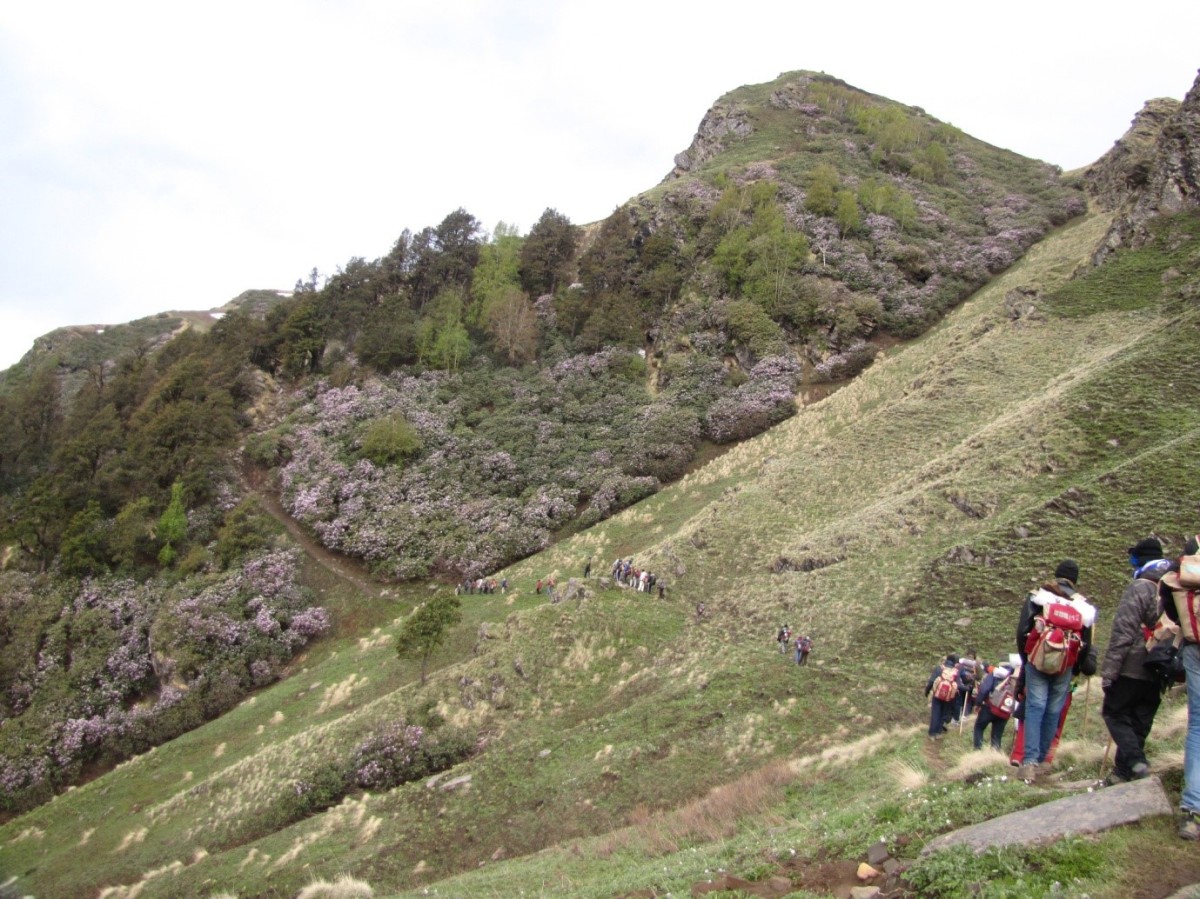
A long trail
We tried our best to capture them in our cameras, however, after seeing the results, I felt that the God made eyes are the best in comparison to man-made camera lenses.
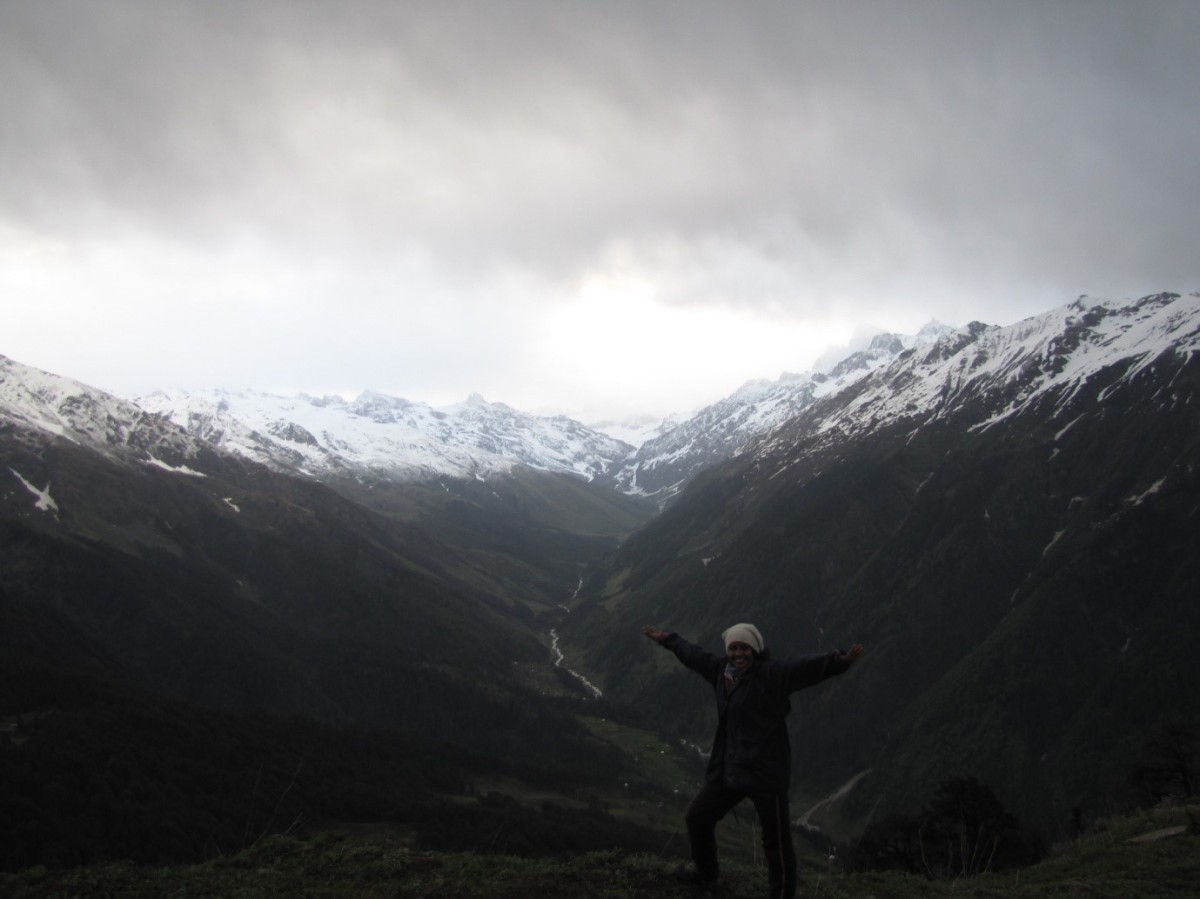
A breathtaking view of the mountains during the trekking
We trekked on rocky and uneven trails. They required the proper strategy to climb up to the next rock. The most amazingly killing experience for me was running crazily on the sloping valleys. I was actually dreaded by the thoughts of slipping down and breaking my bones, however, it turned out to be an amazing experience.
After trekking on rocky trail, the moment came for which all the trekker had waited…..walking on snow.
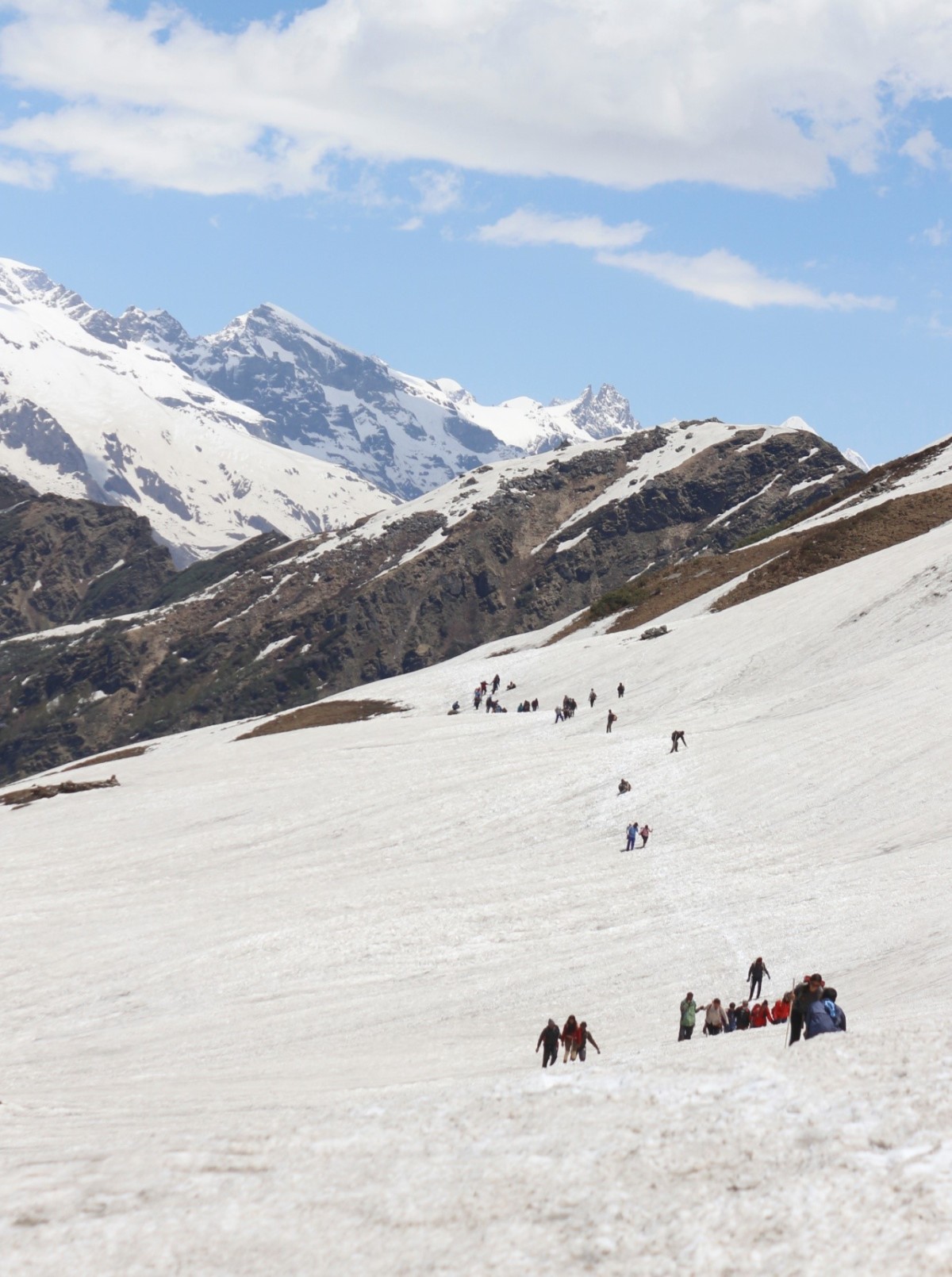
Walking on snowy edge is difficult as it becomes very slippery due to the melting snow.
Photo Gratitude: Ravindra Chouhan Sir
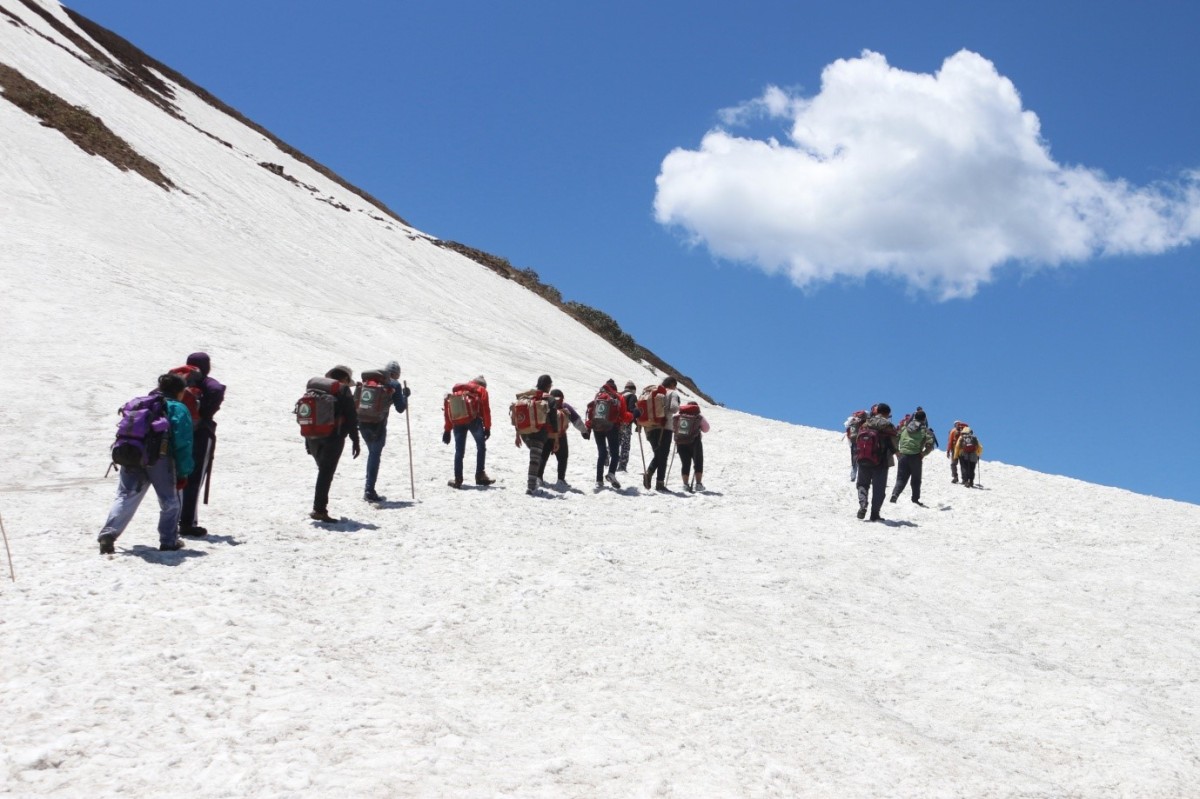
Trekking on snow trail
Photo Gratitude: Ravindra Chouhan Sir
One of the co-trekkers faced breathlessness and oxygen had to be provided to her. Soon we reached the Chanderkhani Pass.
As I summit the Chandrakhani Pass, I realized that the following saying is completely true. “Somewhere between the bottom of the climb and the summit is the answer to the mystery why we climb.” — Greg Child.
We had reached the highest altitude point (3660 meters) of our trek. Our prize was the highest point of our trekking expedition and the spectacular views of the valley. The views from this point were breathtaking and we were spellbound by the beauty of the great Himalayas. One needs to be there to feel it. It can be felt and not expressed. It provided a panoramic view of the ranges around the Chandrakhani Pass. The views were fabulous and I felt it worthwhile to be at Chandrakhani Pass. That is the beauty of any trekking expedition. Lots of local people were already there to worship their Gods.

Worship Place at Chandrakhani Pass
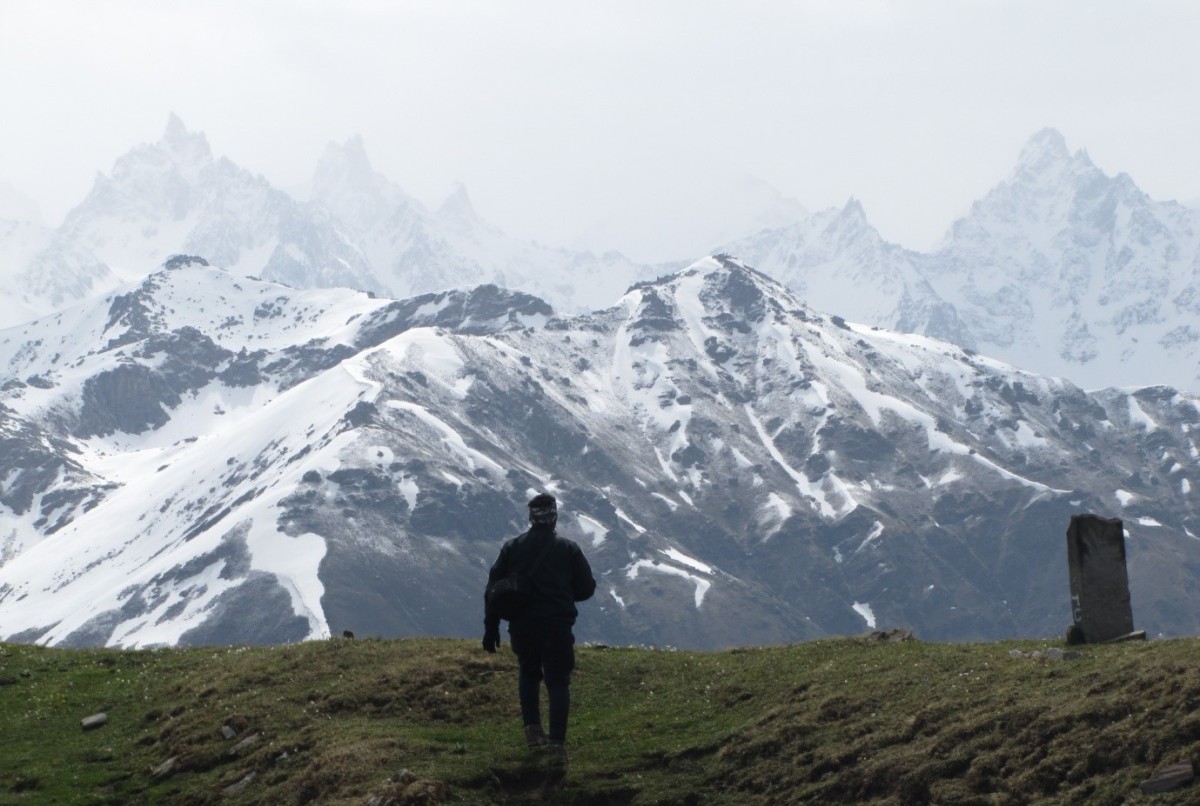
A view of Snow clad peaks from Chandrakhani Pass
We had our mathri and Frooti. From here, the next part of our trek started, which was partly on snow. The snow trek went on smoothly. We also had three snow slides. We were instructed about the manner in which one needs to slide and how to use elbows to apply brakes during the slide. The snow slides were the most enjoyable part of the entire trek. During the first snow slide, trekkers were apprehended, however, after the first slide, their confidence levels resumed to the higher levels and back-benchers came forward and were the first ones to slide. Third slide was a short one.
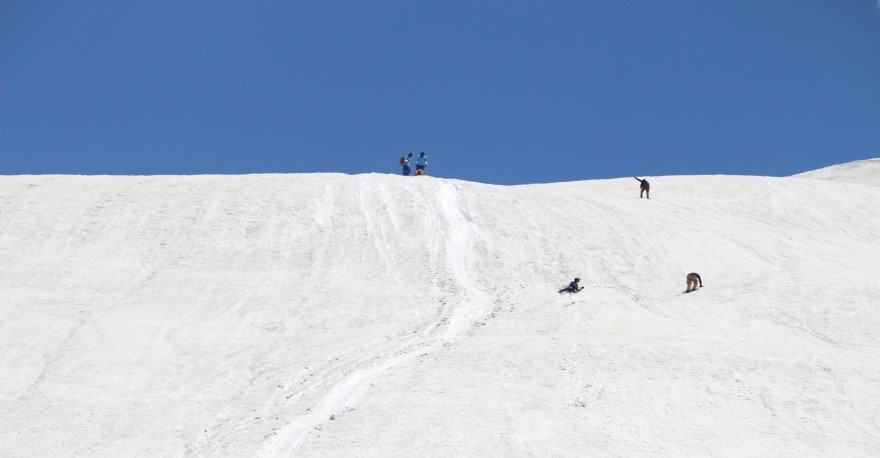
Snow Sliding
Photo Gratitude: Ravindra Chouhan Sir
After that, it was walking on snow-melt muddy water, here trekkers slipped, instead, of crying or getting upset, all of us were laughing and enjoying. The most significant part of this day’s trek was that trekkers had learnt to slip and most importantly rising on their own and laughing at the same time. We were on this trek in the first week of June, therefore, not much snow was there and whatever, was there had started melting. After snow trail, there was a rocky trail. It seemed that someone had put all those rocks intentionally to make it a trek route. It seemed to be river of unending rocks. After rocky trail, it was a broad trail, on which a Maggi point was located. It started drizzling. Some moved ahead and some waited there, enjoying their Maggi. Post-snow sliding, I could not take any photographs as I wanted to enjoy the trekking and I found that my co-trekkers had also not indulged into photography due to battery discharge or their own indulgence into enjoying the trekking and scenic views at the fullest.
Everyone walks according to his or her own pace and momentum. The turning point of the trek or call it a funny point – A few went ahead of us. And suddenly, there were tents which were visible and looked like typical YHAI tents. We were trekking from morning 0330 hours and now it was already 1330 hours. Trekkers were delighted at the sight of the tents and ran towards those tents. When we saw them from above, my co-trekker told me that they are going to wrong tents and asked me to move ahead (The guide had informed my co-trekker about the trek route). I asked my co-trekker to re-confirm. He went ahead and confirmed that our tents were visible from his standing point. Next morning, we were informed that lots of our co-trekkers had taken a wrong route in over-excitement. We trekked, our actual camps were visible. It was raining. We entered into allotted tents. Our Camp Leader was a great person. He came to our tent, asked for a bottle, filled it with hot tomato soup and handed it over to us. We were moved to see such hospitality after a twelve hours strenuous trek. We were also allowed to have lunch inside the tents as all of us were exhausted and it was also raining outside.
By the end of this leg of trek, I realized that “Our greatest glory is not in never falling but in rising every time we fall”- by Confucius.
Day Nine (Final Day): Nauya Tapru to Naggar via Rumsu Village and transfer to Base Camp by Bus, Distance – 7 km (approx) (4 hrs).
The next day, our formal meet with our Camp Leader. He congratulated all of us for completing the most strenuous trek of the entire trekking expedition. He conferred the title, “WARRIORS” to us. Then he briefed us about the day’s trek, that it was all downhill.
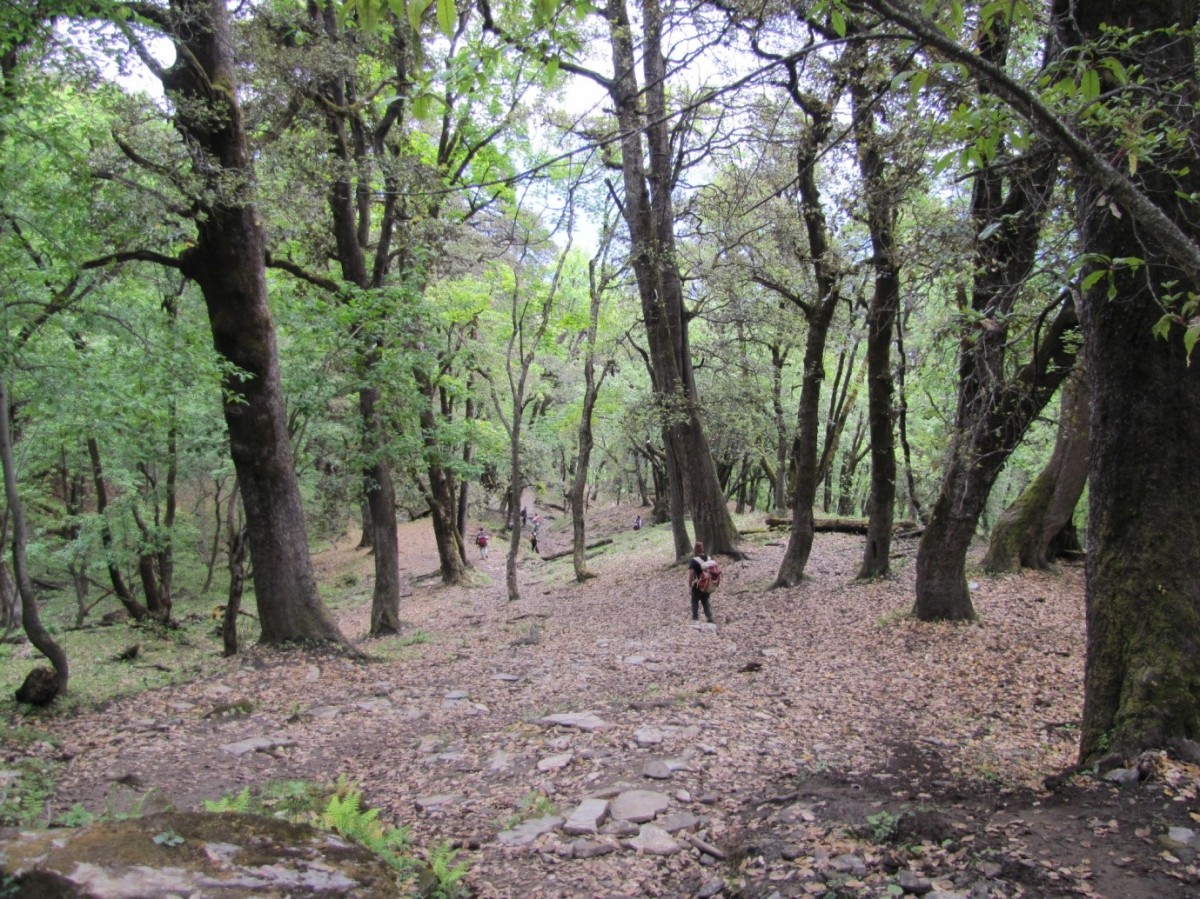
Downhill to Naya Tapru
This trek was all downhill, and here we came across lots of trekkers from foreign countries as well as school children. They chose Naggar-Rumsuk-Naya-Tapru trek route to reach Chanderkhani Pass. The route was through dense forests. The route was an easy one, however, due to the downhill route; it hurt the calves and toes the most. We reached Rumsuk. There were lots of taxis waiting to take us to Naggar Bus Stand. They charged Rs 100 per person. After reaching to Naggar Museum, I was all tired. I requested Indian Curator at the museum to arrange a taxi for me. Even after his engagements at the inauguration of exhibition at Museum, he arranged for a taxi. I took taxi to reach to Naggar and from Naggar, a bus to reach to Seobagh Base Camp. The bus takes Rs 20 per person.
After reaching Base Camp, I finished formalities, took my luggage and was awarded a Certificate of successfully completing the trekking expedition to Chanderkhani Pass.
While penning down my experience, I am once again determined to go for next trekking expedition. “One can’t take a breath large enough to last a lifetime; one can’t eat a meal big enough so that one never needs to eat again. Similarly, I don’t think any climb can make you content never to climb again.” – Woodrow Wilson Sayre
Have you summit Chandrakhani Pass? Which route did you take to summit? What were your experiences?
For part 5, click here: Part 5
For part 1, click here: Part 1
For part 2, click here: Part 2
For part 3, click here: Part 3